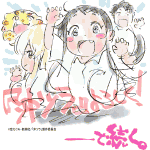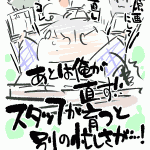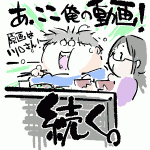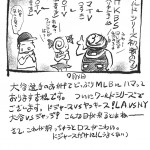No. 292 Between softness and hot-bloodedness ~Let’s do our best~

Welcome back to the I Am Anime website
It’s a belly band cat. I went to the Gekiban Festival “Tokyo Ban Festival 2024” held at Tokyo Tatemono Brillia Hall on November 4th. I wasn’t able to attend their previous performances due to scheduling conflicts, so this was my first time hearing them live. Performers include Tatsuya Kato, Yasuharu Takanashi, Yuki Hayashi, and other musicians. There was a lot to listen to for each of the three, and it was exciting, but personally, I personally liked Tatsuya Kato’s “Shoujo☆Kageki Revue Starlight” and “Love Live! Sunshine!!” and “Free!” It was great to be able to hear the songs live.
What surprised me at the venue was that there were many young women in the audience. And, during the performance, the psyllium is shaken vigorously. I never thought I would see a scene like this at a soundtrack concert! It was a culture shock.
This event made me realize that now is the time to create soundtracks for this kind of audience.
This time, I would like to take a look at the music of the theatrical anime “Ganbatite Imashoi”, which was released on October 25, 2024. This film is based on Ryoko Shikimura’s novel of the same name, directed and written by Yuhei Sakuragi, produced by animation by Moe, and staffed by Rails.
The original novel is a popular work that has been made into a live-action movie version and a TV drama. I have watched both the 1998 live-action movie starring Rena Tanaka and the 2005 TV drama starring An Suzuki. I also bought the soundtrack for the drama version, which was written by Ryo Yoshimata. For me, “Ganbatte Ikimashoi” is a work that I feel a little attached to. It might be better to say that it’s a piece of work that I’m interested in, rather than that I have a strong attachment to it.
“Ganbatte Imashoi” is a story set in Matsuyama City, Ehime Prefecture, in which five girls who attend the same high school join a rowing club and challenge themselves to compete in rowing. Yuhei Sakuragi, the director of the anime version, said that this work was the forerunner of the “girls’ club activities” that were often made in later years (from the pamphlet). If you ask me that, I’d say “K-ON! ” and “Love Live! ‘ can also be called a work that is connected to the lineage of ‘Ganbatte Imashoi’.
However, “Let’s do our best” is “K-ON! It’s not as fluffy as “Love Live!”. ‘I’m not as passionate as that.’ The life-sized characters that oscillated between soft and hot-blooded were appealing. It kind of reminds me of Mitsuru Adachi’s manga. I think that’s what the author was concerned about.
The anime version is characterized by highly saturated images. If you look at the video alone, it looks like CG art. I get the impression that both the character depictions and the drama have been finished in a smooth manner with less vividness. It’s not that I’m not dissatisfied, but I thought, “It’s good to have this kind of “Let’s do our best” attitude.”
The music was composed by Sayuri Hayashi, who is based in Stockholm. The music in the movie is made with a piano-based sound that has a sparkling and floating feel.
Regarding the music of this work, Igneel Hayashi says, “Since this work is set at the sea, I was conscious of expressing the sound of waves and the echoes of the tide through string phrases and instruments.” (From the pamphlet) Composed and recorded in Stockholm. Stockholm, also known as the City of Water, has many islands and canals. Although Igner Hayashi was unable to visit Matsuyama, where the story takes place, she developed her musical ideas while looking at the lights on the water in Stockholm. Musicians from Stockholm will also perform. Perhaps because of this, the resulting music has a slightly exotic feel. This matches the highly saturated CG images.
Although the film is set in a regional Japanese city, the visuals and music do not have a rustic or rustic feel to them. This is what makes the anime version of “Ganbatte Ikimashoi” unique.
The soundtrack album for this work was released on October 25, 2024 by Shochiku Music Publishing/Shochiku Records under the title “Original Soundtrack for the Movie “Ganbatte Imashoi.” There seem to be no plans to release it on CD.
The songs included are as follows.
- Prologue
- The Way to School
- Meeting a New Student
- First Time to the Sea
- We Have New Members!
- Find Your Spark
- Boat Club Practice
- First Tournament
- Lost Dream
- Don’t Lose Hope
- We will Definitely Win!
- Waltz for Five
- Summer Practice
- Back to School
- A Night Festival
- The Fireworks We Watched Together
- Lost Myself
- School Rooftop
- Rainy Day
- Ferris Wheel View
- Come Together
- Give it All
- We got New Uniforms!
- Our Last Tournament
- Us Five
- Epilogue
Music used in the play (play accompaniment) is recorded in the order in which it was used. However, the theme song/insert song sung by the female idol group “Boku ga Miteta Aozora”, the festival music played as real sounds, and pre-made songs are not included.
The first song “Prologue” is the song that plays at the beginning. The sound image of this work’s music is summarized, such as the piano sound like light shining on the surface of the water and the soft sound of the synth reminiscent of shimmering waves. The sound can be interpreted as the mental landscape of the girls.
The second song, “The Way to School,” which plays during the school scene, is impressive in that it includes a sound that imitates the sound of waves. In “First Time to the Sea” (Track 4), the scene where the girls touch a boat for the first time, the high-pitched woodwind melodies evoke the sound of birds gathering on the seashore, and the percussion evokes the image of the splashing of the waves. The idea was to convey the elation of the girls who came to the beach.
Lively and lively songs are also played during daily scenes. “Meeting a New Student” (Track 3) and “We Have New Members!” (Track 5) where the members of the rowing club gather, “Summer Practice” (Track 13) during the summer camp, and the rooftop of the school building. “School Rooftop” (Track 18), a scene where the girls exchange opinions.
“Waltz for Five” (Track 12), written in the style of a Viennese waltz, is a song about a scene where the girls gather at the house of Taeko, a member of the boat club, and its elegant melody creates a humorous effect.
This is one of the songs in this work that feels more like a “girl’s club activity” song.
The songs that depict the girls’ anxiety, sadness, and friendship are written in a subdued, less melodious tone. “Find Your Spark” (Track 6), “Lost Dream” (Track 9), “Lost Myself” (Track 17), “Ferris Wheel View” (Track 20), “Come Together” (Track 21), etc. is a song that plays during important scenes, but it is not intentionally designed to stir the emotions of the audience. It expresses delicate feelings through the overlapping sounds and simple phrases. This is what I feel like “Let’s do our best”.
On the other hand, “First Tournament” (Track 8) and “Our Last Tournament” (Track 24), which play during the boat race scene, are written in a speedy tone with an emphasis on rhythm. I have a good impression of how the parts that need to be excited are well-enlivened and have a nice sharpness to them.
The two songs that are played during the boat training scene, “Boat Club Practice” (track 7) and “We will Definitely Win!” (track 11), are slightly different songs in this work.
Both songs quote the melody of the Matsuyama folk song “Yakkyuken”. I didn’t know that Yakyuken was Yukari Matsuyama, so when I first heard the song, I was surprised to see what was going on. The melody is folk song-like, but the sound is modern and has a slightly humorous feel. This alien feeling softens the impression of what could have been a hot and humid scene. Apparently, the quote from “Yakkyuken” was a request from director Yuhei Sakuragi, and I thought it was a surprising and interesting production (though it may not have been intended to be a surprise).
Lastly, I would like to introduce a song that particularly left an impression on me among the music in this work.
The two songs include “Rainy Day” (track 19) and “Us Five” (track 25), which feature female vocals. Both have the same melody, and the vocals have lyrics.
“Rainy Day” is a scene in which the girls spend time together after they are no longer able to practice rowing, and “Us Five” is played in the final scene of a rowing competition in which five people row together as one. Regarding these two songs, director Yuhei Sakuragi apparently ordered them to “not make them sound like they were sung by professionals.” Perhaps because of this, I can’t hear the lyrics clearly. It doesn’t seem to be Japanese, but I’m not sure if it’s English or another language. But that’s probably fine.
It is my imagination that these two songs are the voices of the girls’ hearts rather than insert songs. The tone of voice and facial expressions themselves have meaning. If you use clear words, subtle nuances will be lost and there will be no room for imagination. Each person in the audience who listens to the vocals should imagine the feelings of the girls while watching the performance. At that time, one’s own experiences and memories may also be drawn out. That’s probably the purpose of the song.
Out of all the scenes, the scene where these two songs are played is clearly memorable. If it were a typical work, it would probably be a tear-jerking song with clear lyrics, but it’s clever to have a song with a mysterious, stateless feel to it. You can feel the commitment of director Yuhei Sakuragi and Sayuri Hayashi to this film.
When you unravel the music production in this way, you can understand that even though the anime version has a different look, it is still “Let’s do our best”. I think the charm of “Ganbatete Ikimashoi,” which oscillates between soft and hot-blooded, has been carried over into the theatrical anime.
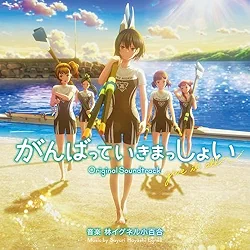
Original soundtrack of the movie “Let’s do our best”
Amazon
